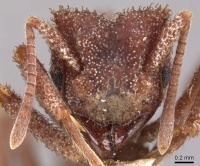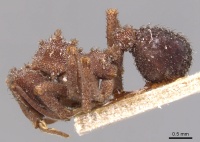Mycetomoellerius farinosus
| Mycetomoellerius farinosus | |
|---|---|

| |
| Scientific classification | |
| Kingdom: | Animalia |
| Phylum: | Arthropoda |
| Class: | Insecta |
| Order: | Hymenoptera |
| Family: | Formicidae |
| Subfamily: | Myrmicinae |
| Tribe: | Attini |
| Genus: | Mycetomoellerius |
| Species: | M. farinosus |
| Binomial name | |
| Mycetomoellerius farinosus (Emery, 1894) | |
| Synonyms | |
| |
Identification
Santos et al. (2025) provide a multi-entry interactive key based on the xper3 platform which contains 27 characters and, as terminals, 30 species of Mycetomoellerius, representing almost all described species except for Mycetomoellerius echinus, Mycetomoellerius gaigei and Mycetomoellerius guianensis, which are excluded due to lack of clear information or available specimens for study.
Distribution
Latitudinal Distribution Pattern
Latitudinal Range: 5.266667° to -64.23°.
| North Temperate |
North Subtropical |
Tropical | South Subtropical |
South Temperate |
- Source: AntMaps
Distribution based on Regional Taxon Lists
Neotropical Region: Brazil (type locality), Ecuador, Guyana, Peru.
Distribution based on AntMaps
Distribution based on AntWeb specimens
Check data from AntWeb
Countries Occupied
| Number of countries occupied by this species based on AntWiki Regional Taxon Lists. In general, fewer countries occupied indicates a narrower range, while more countries indicates a more widespread species. |

|
Estimated Abundance
| Relative abundance based on number of AntMaps records per species (this species within the purple bar). Fewer records (to the left) indicates a less abundant/encountered species while more records (to the right) indicates more abundant/encountered species. |

|
Biology
|
Castes
Nomenclature
The following information is derived from Barry Bolton's Online Catalogue of the Ants of the World.
- farinosus. Atta (Trachymyrmex) farinosa Emery, 1894c: 221 (w.) BRAZIL.
- Combination in Trachymyrmex: Gallardo, 1916b: 242.
- Combination in Mycetomoellerius: Solomon et al., 2019: 948.
- Senior synonym of trifurcatus: Weber, 1958b: 51.
- trifurcatus. Trachymyrmex trifurcatus Weber, 1938b: 199 (w.) GUYANA.
- Junior synonym of farinosus: Weber, 1958b: 51.
Description
References
- Albuquerque, E., Prado, L., Andrade-Silva, J., Siqueira, E., Sampaio, K., Alves, D., Brandão, C., Andrade, P., Feitosa, R., Koch, E., Delabie, J., Fernandes, I., Baccaro, F., Souza, J., Almeida, R., Silva, R. 2021. Ants of the State of Pará, Brazil: a historical and comprehensive dataset of a key biodiversity hotspot in the Amazon Basin. Zootaxa 5001, 1–83 (doi:10.11646/zootaxa.5001.1.1).
- Emery, C. 1894d. Studi sulle formiche della fauna neotropica. VI-XVI. Bull. Soc. Entomol. Ital. 26: 137-241 (page 221, worker described)
- Gallardo, A. 1916c. Notas acerca de la hormiga Trachymyrmex pruinosus Emery. An. Mus. Nac. Hist. Nat. B. Aires 28: 241-252 (page 242, Combination in Trachymyrmex)
- Santos, C.D.A.D., Chaul, J.C.M., Serrao, J.E. 2025. Taxonomic contributions to Mycetomoellerius Solomon et al., 2019 (Hymenoptera: Formicidae: Myrmicinae): description of two new species and a key for the genus. Zootaxa 5569(1), 93–118 (doi:10.11646/zootaxa.5569.1.3).
- Solomon, S.E., Rabeling, C., Sosa-Calvo, J., Lopes, C.T., Rodrigues, A., Vasconcelos, H.L., Bacci Jr, M., Mueller, U.G., Schultz, T.R. 2019. The molecular phylogenetics of Trachymyrmex Forel ants and their fungal cultivars provide insights into the origin and coevolutionary history of ‘higher-attine’ ant agriculture. Systematic Entomology 44: 939-956 (doi:10.1111/syen.12370).
- Weber, N. A. 1958b. Nomenclatural changes in Trachymyrmex (Hym.: Formicidae). Entomol. News 69: 49-55 (page 51, senior synonym of trifurcatus)
References based on Global Ant Biodiversity Informatics
- Baccaro F. B., I. F. Rocha, B. E. G. del Aguila, J. Schietti, T. Emilio, J. L. Purri da Veiga Pinto, A. P. Lima, and W. E. Magnusson. Changes in Ground-dwelling Ant Functional Diversity are Correlated with Water-Table Level in an Amazonian Terra Firme Forest. Biotropica 45(6): 755-763.
- Emery C. 1894. Studi sulle formiche della fauna neotropica. VI-XVI. Bullettino della Società Entomologica Italiana 26: 137-241.
- Fernandes I., and J. de Souza. 2018. Dataset of long-term monitoring of ground-dwelling ants (Hymenoptera: Formicidae) in the influence areas of a hydroelectric power plant on the Madeira River in the Amazon Basin. Biodiversity Data Journal 6: e24375.
- Fichaux M., B. Bechade, J. Donald, A. Weyna, J. H. C. Delabie, J. Murienne, C. Baraloto, and J. Orivel. 2019. Habitats shape taxonomic and functional composition of Neotropical ant assemblages. Oecologia 189(2): 501-513.
- Franco W., N. Ladino, J. H. C. Delabie, A. Dejean, J. Orivel, M. Fichaux, S. Groc, M. Leponce, and R. M. Feitosa. 2019. First checklist of the ants (Hymenoptera: Formicidae) of French Guiana. Zootaxa 4674(5): 509-543.
- Groc S., J. H. C. Delabie, F. Fernandez, F. Petitclerc, B. Corbara, M. Leponce, R. Cereghino, and A. Dejean. 2017. Litter-dwelling ants as bioindicators to gauge the sustainability of small arboreal monocultures embedded in the Amazonian rainforest. Ecological Indicators 82: 43-49.
- Kempf, W.W. 1972. Catalago abreviado das formigas da regiao Neotropical (Hym. Formicidae) Studia Entomologica 15(1-4).
- Mayhe-Nunes A. J., and K. Jaffe. 1998. On the biogeography of attini (Hymenoptera: Formicidae). Ecotropicos 11(1): 45-54.
- Mertl A. L., J. F. A. Traniello, K. Ryder Wilkie, and R. Constantino. 2012. Associations of two ecologically significant social insect taxa in the litter of an amazonian rainforest: is there a relationship between ant and termite species richness? Psyche doi:10.1155/2012/312054
- Ryder Wilkie K.T., A. L. Mertl, and J. F. A. Traniello. 2010. Species Diversity and Distribution Patterns of the Ants of Amazonian Ecuador. PLoS ONE 5(10): e13146.doi:10.1371/journal.pone.0013146
- Silvestre R., C. R. F. Brandão, and R. R. Silva da 2003. Grupos funcionales de hormigas: el caso de los gremios del cerrado. Pp. 113-148 in: Fernández, F. (ed.) 2003. Introducción a las hormigas de la región Neotropical. Bogotá: Instituto de Investigación de Recursos Biológicos Alexander von Humboldt, xxvi + 424 pp.
- Souza J. L. P., F. B. Baccaro, P. A. C. L. Pequeno, E. Franklin, and W. E. Magnusson. 2018. Effectiveness of genera as a higher‑taxon substitute for species in ant biodiversity analyses is not affected by sampling technique. Biodiversity and Conservation 27(13): 3425–3445.
- Vasconcelos, H.L., J.M.S. Vilhena, W.E. Magnusson and A.L.K.M. Albernaz. 2006. Long-term effects of forest fragmentation on Amazonian ant communities. Journal of Biogeography 33:1348-1356
- Weber N. A. 1946. The biology of the fungus-growing ants. Part IX. The British Guiana species. Revista de Entomologia (Rio de Janeiro) 17: 114-172.
- Weber N. A. 1958. Nomenclatural changes in Trachymyrmex (Hym.: Formicidae). Entomological News 69: 49-55.
- Wheeler W. M. 1916. Ants collected in British Guiana by the expedition of the American Museum of Natural History during 1911. Bulletin of the American Museum of Natural History 35: 1-14.
- Youngsteadt, E., Alvarez Baca, J., Osborne, J. & Schal C (2009) Species-specific seed dispersal in an obligate ant-plant mutualism. PLoS ONE, 4, e4335.doi:10.1371/journal.pone.0004335
- da Silva de Oliveira A. B., and F. A. Schmidt. 2019. Ant assemblages of Brazil nut trees Bertholletia excelsa in forest and pasture habitats in the Southwestern Brazilian Amazon. Biodiversity and Conservation 28(2): 329-344.
- da Silva, R.R., C.R.F. Brandao, and R. Silvestre. 2004. Similarity Between Cerrado Localities in Central and Southeastern Brazil Based on the Dry Season Bait Visitors Ant Fauna. Studies on Neotropical Fauna and Environment 39(3):191-199.

